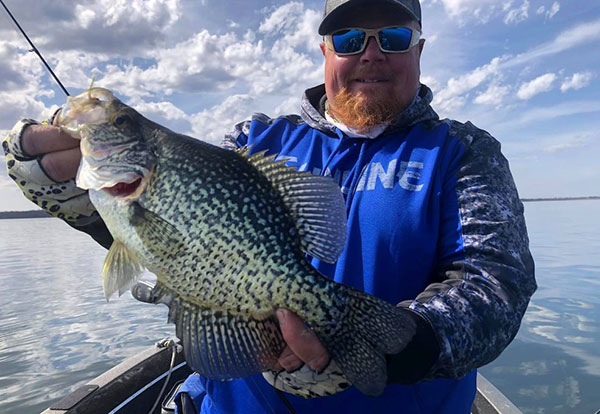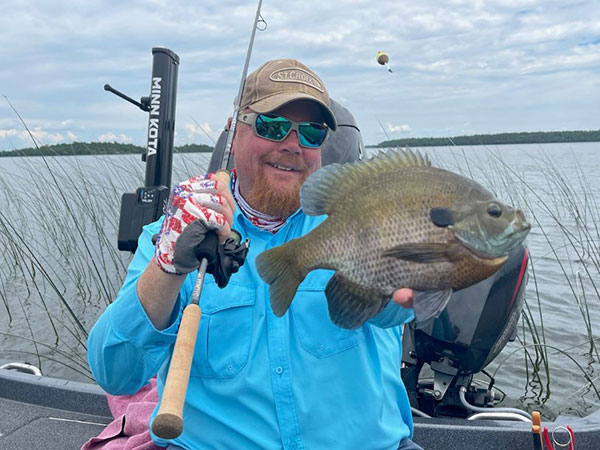St. Croix Report
 Brian “Bro” Brosdahl
Brian “Bro” Brosdahl
Brian “Bro” Brosdahl, a prolific fishing guide with a penchant for all things panfish has been on the leading edge of bluegill, crappie, and perch-fishing techniques and innovations for well over two decades now.
While Bro pursues panfish year-‘round, he gets particularly giddy come ice out.
“Wintertime sticks around for a long time in Northern Minnesota,” the St. Croix pro says. “While you’ve always got something going on beneath the ice, most northern anglers are eager to make the switch to open-water fishing as soon as the ice goes out.” And for good reason. Bro says the months of April, May, and June bring some of the best panfishing conditions and opportunities of the entire year.
“Of course you’ve got the unique aspects of the spawn – perch and crappies first and then the ‘gills – but those details aside, the common denominator for springtime panfishing is shallow water,” Bro advises. “It’s the first water to warm, so it’s where the weeds get growing and where concentrations of bait begin to get active. As a result, it’s where the panfish want to be, too.”
Bro says he spends ample time covering warming, shallow-water flats by casting micro jigs early in the season. “I’m looking for any weed growth,” he says. “The fish I’m hunting are often scattered in less than six feet of water. I’m usually searching with a Northland Thumper Jig or a Fire-Fly Jig tipped with a wax worm or a small crappie minnow.” Bro says he rigs with eight-pound Sunline green braid with a four-pound fluoro leader. His rod of choice is a 7’ light power, extra-fast action St. Croix spinning rod.
Bro says fish pushing shallow into warmer water are generally just following bottom contours wherever the conditions suit them. That’s why he uses the sonar tools at his disposal to find them. “You can pull up on a springtime panfish flat and easily spook fish if you don’t know where they’re at,” he says. I’ll use my Talon shallow-water anchor instead of my trolling motor to minimize the disruption.”
Once Bro finds the size and concentrations of fish he’s after, he’ll go to a shorter rod with a tiny jig presented beneath a slip bobber. “I’ll use six-pound mono with a four-pound fluoro leader and a Northland Lite Bite slip bobber,” Bro reports. “If you get hung up, you want your leader to break instead of your main line so you can get back in the game that much faster. I like the Lite Bite bobbers because they are slightly weighted with a brass grommet so you don’t need any other weight on your leader. That really reduces tangles and other frustrations when casting this rig,“ he says.
 Brian “Bro” Brosdahl
Brian “Bro” Brosdahl
Before there’s any significant weed growth in the shallows, Bro often follows beaver activity to panfish nirvana. “I often do better on beaver chew – the loose branches floating around – than on the dams themselves,” he says. “I’m looking hard at anything significant enough to provide some cover. Of course, the deeper runways leading to the dams hold fish and the dams do, too. They’re just a bit trickier to fish because the fish are often tucked up all the way into the dam.”
Once green weeds start to sprout on the shallow flats, Bro says the crappies, bluegills and perch spread out a bit and become a bit less spooky, especially when there’s some wave action. “ Once the water warms up a bit the fish move closer to the surface,” Bro says. “Lakes with patches of rushes or cane in three-to-six feet of water become hot. That’s when I become a crane operator,” says Bro, referring to the use of the 9’ model in St. Croix’s Avid Panfish, Panfish, and Legend Elite Panfish series. “I can pitch and even drop vertically into the openings in the rushes,” he says. “Even though they may still be rotten from the winter, they’re still strong enough to break your line. A long rod allows me to drop into the voids and pluck and pull ‘gills, crappies, and perch straight up so I can fight them on the surface to avoid tangles and break-offs.” Bro says Fire-Fly feather jigs in pink/white, greens, black/yellow bring him consistent results when “craning”, adding that small plastics work great, too, as do ice fishing lures like a Bro Mudbug tipped with waxies.
Bro says once the weeds really start growing, they represent the best options for finding mature, springtime panfish. “Invasive milfoil grows really quickly in the springtime, and once it’s up the fish never really leave it,” he says. “It can be difficult to fish, but it’s easiest when it’s only up about three to four feet off the bottom. I’m often fishing vertically right in the sonar cone so I can watch what’s happening. The fish aren’t scared down there in that thick stuff, but subtle presentations still rule. I’m just moving my rod tip with micro-movements.”





